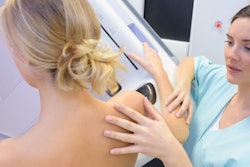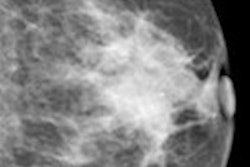When paired with mammography, dual-energy contrast-enhanced digital mammography (CEDM) is more diagnostically accurate than mammography or mammography plus ultrasound, according to a study in the March European Radiology.
Radiologists struggle with identifying breast cancer using conventional mammography in women with dense breasts. One way to rectify the problem is the addition of ultrasound, which has already been well-established by previous research, including the American College of Radiology Imaging Network (ACRIN) 6666 trial. However, ultrasound carries its own set of problems, namely operator dependence.
Thus far, the most sensitive means to detect angiogenesis is through contrast-enhanced breast imaging techniques such as CT and MRI, which track contrast agent uptake and washout in tissues. However, CT has high radiation dose levels and MRI has high false-positive rates and higher costs. Therefore, dual-energy CEDM has the potential to capture the best of all worlds -- lower costs but higher detection rates.
In their prospective study, Dr. Clarisse Dromain, from the department of imaging at the Institut de Cancérologie Gustave-Roussy in Villejuif Cedex, France, and colleagues included 120 women with 142 suspect findings detected via mammography and/or mammography plus ultrasound. All of those women underwent CEDM. Low- and high-energy images were acquired using a modified full-field digital mammography system. Images were acquired in the mediolateral oblique view at two minutes and in the craniocaudal view at four minutes after the injection of 1.5 mL/kg of an iodinated contrast agent (European Radiology, March 2011, Vol. 21:3, pp. 565-574).
Dromain and her team found 62 benign and 80 malignant lesions -- identified from pathology and follow-up. Areas under the receiver operator characteristics (ROC) curves were significantly superior for mammography plus CEDM than for mammography alone, or mammography plus ultrasound. Mammography plus CEDM showed 93% sensitivity when compared with mammography (78%) with no loss in specificity.
The researchers also found all 23 multifocal lesions were correctly detected by the mammography/CEDM pair versus only 16 with mammography and 15 with mammography/ultrasound.
"Compared with the standard of care for diagnostic procedures, CEDM had a better diagnostic accuracy mainly due to improved specificity, and better positive and negative predictive values," the authors wrote. "CEDM has the advantage of being reproducible without operator dependency."
After some specific software and hardware adaptations for acquisition and image processing, contrast-enhanced digital mammography can be performed by using a current digital mammography system, according to the authors.
"CEDM is of interest in the nonscreening setting and has the potential to increase the cancer detection rate, to improve staging, and to improve the selection of patients for biopsy," they wrote.
The results of their study encourage more studies to define the place of CEDM among the other breast imaging methods, according to the authors.




















